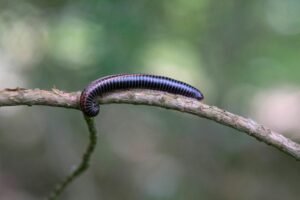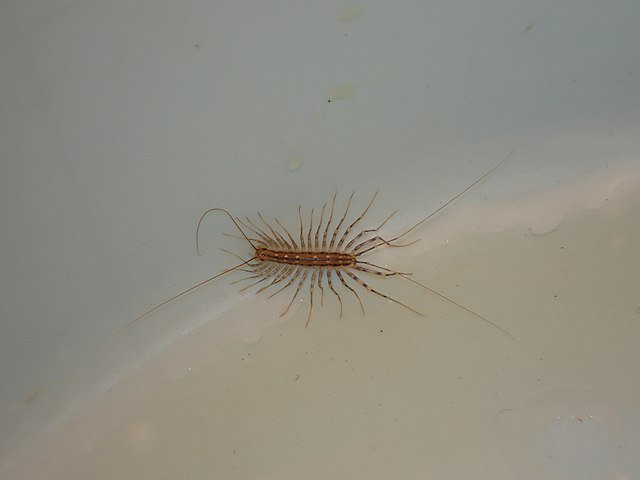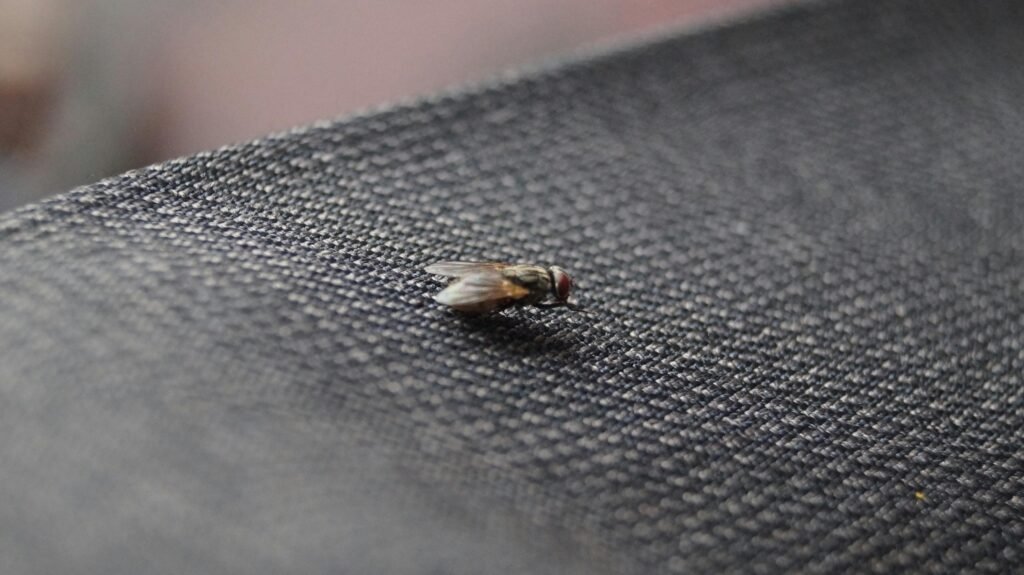Millipedes Indoors: Biology, Risks, and How to Get Rid of Them
 Millipedes are among the most common crawling pests people notice inside their homes, especially during damp weather. They are long, brown or black creatures with many tiny legs. Even though they are not dangerous, their sudden appearance in large numbers can be unsettling. Understanding their biology, habits, and control methods helps you manage an infestation and prevent future problems.
Millipedes are among the most common crawling pests people notice inside their homes, especially during damp weather. They are long, brown or black creatures with many tiny legs. Even though they are not dangerous, their sudden appearance in large numbers can be unsettling. Understanding their biology, habits, and control methods helps you manage an infestation and prevent future problems.
What Are Millipedes?
Millipedes are arthropods, meaning they belong to the same broad family as insects, spiders, and crustaceans. They are not insects because their body is divided into many segments, each carrying two pairs of legs. Adult millipedes usually measure between 2 and 4 centimeters in length, but some tropical species can be much larger. In most temperate countries, the common species found in houses are small and slow-moving.
The word "millipede" means "thousand feet," but no millipede really has that many. Most species have between 80 and 400 legs, depending on age and size. They curl into a spiral when disturbed, which helps protect their softer underside from predators.
Millipede Biology and Habits
Millipedes are detritivores. This means they feed on dead plant material, rotting wood, fallen leaves, and other organic matter. In nature, they play an important role by recycling nutrients back into the soil. Outdoors they are beneficial, but indoors they are unwanted.
They prefer moist, dark environments. Their bodies lose water quickly, so they need humidity to survive. That is why they are usually found under stones, logs, mulch, or in damp soil. When heavy rain floods their habitat, they migrate to higher ground, often ending up inside buildings.
Millipedes are most active at night. During the day they hide in cracks and crevices. They cannot climb smooth surfaces very well, but they can crawl up rough walls, foundations, or basement windows.
Why Millipedes Enter Homes
 There are several reasons millipedes may move indoors:
There are several reasons millipedes may move indoors:
Excess moisture outdoors: After long periods of rain, the soil becomes waterlogged and millipedes seek drier shelter.
Dry or hot conditions: In some regions, drought forces millipedes to move indoors to find humidity.
Disturbance of habitat: Gardening, digging, or removing mulch may cause them to look for new hiding places.
Open entry points: Cracks, gaps under doors, or broken screens allow them easy access.
Once inside, they are usually found in basements, bathrooms, laundry rooms, or other damp areas.
Are Millipedes Dangerous?
Millipedes are not harmful to people, pets, or buildings. They do not bite or sting. They cannot damage furniture or stored food. However, they can produce a mild defensive chemical when handled. This secretion may cause skin irritation or a temporary stain, but it is not poisonous. Washing hands after contact is enough to avoid problems.
Millipedes do not transmit diseases to humans or animals. They are considered nuisance pests rather than health threats. Their presence in large numbers, however, can cause stress and discomfort, especially when they keep reappearing every season.
How to Identify a Millipede Infestation
Signs of millipedes indoors include:
Seeing them crawling on floors, especially near doors or windows.
Finding them curled up and dead, often in large groups near entry points.
Noticing them mainly during wet or humid weather.
Unlike other pests, millipedes do not reproduce inside houses. If you see them indoors, they have migrated from outside. They usually die quickly in the dry indoor environment, which is why dead millipedes are often found in piles.
Preventing Millipede Infestations
The most effective way to control millipedes is to prevent them from entering in the first place.
Moisture control:
Use a dehumidifier in basements and crawl spaces.
Fix leaking pipes or taps.
Improve ventilation in bathrooms and laundry rooms.
Seal entry points:
Install door sweeps and weatherstripping.
Repair cracks in walls and foundations.
Replace damaged screens and window seals.
Outdoor habitat reduction:
Keep mulch, compost, and leaf piles away from the house foundation.
Store firewood at least 20–30 centimeters above the ground and away from walls.
Trim back plants that keep soil constantly damp near the house.
Landscape adjustments:
Ensure water drains away from the foundation.
Clean gutters and downspouts to prevent standing water.
These steps reduce the number of millipedes living near the house and make it harder for them to enter.
How to Get Rid of Millipedes Indoors
Once millipedes are inside, chemical treatments are usually unnecessary. Here are the best approaches:
Vacuuming: The simplest method is to vacuum them and dispose of the bag immediately.
Manual removal: Sweep them into a dustpan and discard them outdoors.
Dry environment: Lower indoor humidity so they cannot survive.
Because they die quickly inside, waiting a few days often resolves the problem. Still, repeated invasions can be frustrating.
Natural Remedies for Millipedes
Some homeowners prefer natural approaches to control:
Diatomaceous earth: Sprinkling food-grade diatomaceous earth near entry points can dry out and kill millipedes.
Essential oils: Peppermint or tea tree oil sprays may repel them temporarily, although scientific proof is limited.
Sticky traps: Placing traps near doors and windows can capture wandering millipedes.
These methods are safe but may not be effective against large outdoor populations.
Chemical Control Options
When infestations are heavy, professionals may apply insecticides outside the house, around foundations, and near entry points. Commonly used products include residual sprays or granules that create a protective barrier. Indoor spraying is rarely needed and usually discouraged, since millipedes do not breed inside.
Chemical control should always be combined with prevention measures. Relying only on pesticides without fixing moisture and entry problems will not solve the issue long-term.
Professional Pest Control
A licensed pest control company can inspect your property, identify entry points, and apply safe treatments around your home. They may also recommend structural improvements to reduce future infestations. Professional help is recommended when:
Millipedes appear indoors every season in large numbers.
Moisture problems cannot be solved easily.
DIY methods fail to control the situation.
Millipedes vs. Centipedes
Many people confuse millipedes with centipedes. Centipedes have one pair of legs per body segment and move quickly. They are predators and can bite, though rarely harmful to humans. Millipedes, on the other hand, are slow, have two pairs of legs per segment, and are harmless. Knowing the difference helps you decide if action is necessary.
Key Takeaways
Millipedes are harmless but become nuisance pests when they invade homes.
They need moisture and usually enter during wet weather.
They do not reproduce indoors or spread diseases.
Prevention through moisture control, sealing, and habitat reduction is the best strategy.
Professional help is useful for recurring or heavy infestations.
Disclaimer
This article is for informational purposes only. Pest control laws and approved chemicals vary by country. For best results and legal safety, we strongly recommend contacting a licensed pest control professional in your local area. Always make sure that the pest control technician is properly certified or licensed, depending on your country’s regulations. It’s important to confirm that they only use approved products and apply them exactly as instructed on the product label. In most places in Europe, UK, or USA, following label directions is not just best practice—it’s the law.
Author
Nasos Iliopoulos
MSc Agronomist & Certified Pest Control Expert
Scientific Director, Advance Services (Athens, Greece)
Licensed Pest Control Business – Ministry of Rural Development & Food (GR)
References
North Carolina State University Extension. "Millipedes."
University of Florida IFAS. "Millipede Biology and Control."
- Britannica. Millipede


